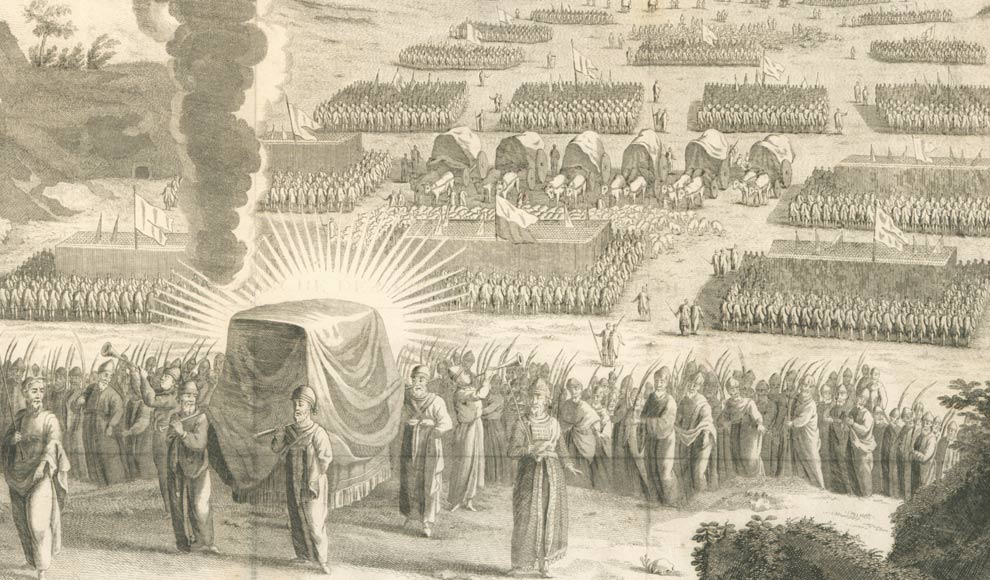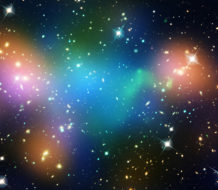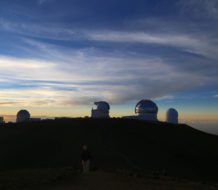The mythic paradigm of the Exodus narrative describes the inexorable triumph of the life-force over death, of wholeness over brokenness. In this narrative, Miriam, sister of Moses, represents a key figure: she assists in the plan to rescue her vulnerable infant brother Moses from Pharaoh’s infanticide, watches over him as he floats in a basket in the Nile, and engineers the arrangement by which he is adopted by Pharaoh’s daughter and nursed by his own mother.
Jewish legend teaches as well that after the Israelites had fled from enslavement in Egypt, they were accompanied on their journeys through the Sinai wilderness by a water source associated with Miriam. Wherever the people traveled, whatever travails they experienced along the way, Miriam’s well provided sustenance and healing. While such a well is not mentioned in the Torah itself, the classical rabbis inferred its existence because of the sudden absence of water after the death of Miriam.
In this mythic model, the waters of Miriam’s well signify the forces which, in an ongoing manner, preserve and sustain life. These forces can be understood in both material and immaterial senses. Water, air, and the elements of life sustain our environment and ourselves; we are dependent upon them for our continued survival. Some might add that we are dependent as well upon the human support of family, friends, and community in order to survive. And others might say as well that our existence as human beings depends upon a life force which nourishes us in non-material ways, as well.
While there is no singular accepted definition of spirituality, many understand the term to mean a sense of connection to something beyond the self, to a reality that is greater or deeper than the individual. We can understand personal spirituality as the capacity to experience one’s self as part of as a greater whole, providing a sense of transcendent purpose.
The converse of spirituality, in this understanding, is a sense of alienation, isolation, and disconnection from something beyond the self. Twelve Step programs describe themselves as a spiritually-based program to help individuals recover from addictive patterns of behavior used to medicate or avoid painful emotions, such as excessive shame or pain. They seek to address addicts’ frequently deep sense of alienation and disconnection by suggesting that they accept a “Higher Power” or develop a personal relationship with a “God of his/her understanding.”
In the framework of recovery programs, a spiritual approach may consist simply of understanding the group itself as a “Higher Power” providing an essential sense of love and support for the recovering addict. Frequently, the experience of connection to the group of fellow recovering people opens the door to the possibility of a sense of connection with a non-material source of support and connection – a “God of one’s understanding.”
Every human being, being singular and unique, wrestles at points in life with an existential sense of alienation and disconnection. We experience moments of “dryness” or emptiness, when we may feel depleted, depressed, even despairing. For some, the sense of disconnection may be physiological or biochemical, and virtually impossible to overcome on one’s one.
These moments of “dryness” may be understood as corresponding to the point in the mythic narrative of the Israelites’ trek through the wilderness when Miriam dies and no water is to be found. Each of us experiences as well moments of replenishment, when we are imbued with new sources of energy, faith and hope. These are reflected in the narrative when Miriam’s well provides the resources needed to move through the challenges of their journey.
In Jewish sacred texts, the Hebrew word hineini — literally translated as “here I am” connotes a profound sense of presence, openness and receptivity. It indicates the human experience of profound connection to the lived moment. In many narratives, this word is used to indicate a state of being which enables one to face what may otherwise be viewed as insurmountable obstacles. For example, at the burning bush, hearing the “call” of the Divine inviting him to return to Egypt and lead his people to freedom, Moses experiences self-doubt and fear of the unknown – and yet responds, “hineini – here I am.”
Thus, a sense of connection – whether to a moment in time, to other human beings, or to a Force, Power, or Transcendent Being – is a hallmark of spirituality. We can foster awareness of those connections by meditating, praying, communing with nature, cultivating relationships with family and friends, and/or by being of service to our fellow human beings: essentially “plugging ourselves into the grid,” linking our lives with the greater reality which sustains life, thereby adding to our capacity to meet life’s inevitable challenges and rebound from our setbacks.
As individuals, each of us may have our own preferred mode of tapping into this source of replenishment, consonant with our unique personalities and temperaments. Some connect through solitude or silence; others through connection with community, through words and/or song. Whatever the preferred mode, a regular practice of cultivating connection reduces stress and increases capacity to cope with challenge.
The Eleventh Step of Alcoholics Anonymous calls for seeking, through a regular practice of prayer or meditation “to improve our conscious contact with God, as we understand God….” The literature of A.A. describes in this way the role that prayer and meditation play in providing a source of renewal in its practitioners’ lives:
Those of us who have come to make regular use of prayer would no more do without it than we would refuse air, food or sunshine. And for the same reason. When we refuse air, light or food the body suffers. And when we turn away from meditation and prayer, we likewise deprive our minds, our emotions and our intuitions of vitally needed support. As the body can fail its purpose for lack of nourishment, so can the soul. We all need the light of God’s reality, the nourishment of His strength, and the atmosphere of His grace. (Twelve Steps and Twelve Traditions, p. 97-98, emphasis added).
When spirituality is construed in this broad sense, embracing diverse modes by which one might experience connection to a reality beyond or deeper than oneself, new resources for negotiating life’s hills and valleys become accessible. Regardless of one’s belief or non-belief in a personal deity, there is power in recognizing the numerous ways in which one is inextricably connected to the fabric of life. Through prayer, meditation, appreciation of the natural world, or fostering deeper relationships with others, we are able to replenish ourselves from sources of sustenance beneath life’s surface, even when journeying through seemingly parched landscapes; all that is required is the willingness to pause, listen deeply, and notice the myriad ways in which our bodies, minds and souls can be replenished, each moment of our lives.
Discussion Questions:
1. How do you understand the concept of spirituality?
2. Do you believe that spirituality is essential to cultivating personal resilience and inner strength? Why?
Discussion Summary
In this essay on “the role of spirituality in inner strength or resourcefulness,” I attempted to describe spirituality in a way that — as George Gantz noted in his thoughtful comment — might bridge the gap between those who are comfortable describing themselves as “religious” or “God-believers,” and those who understand themselves as secular or at least non-theistic in their approaches to the Divine. (The 2012 Pew Religion and Public Life Project Study revealed that seven per cent of Americans consider themselves “spiritual but not religious” a much larger group than Jews, Muslims, or Episcopalians.)
Of course, there is no “one size fits all” definition of spirituality, which for both “religious” and “secular” individuals can be an alienating term. I was trying to formulate a broad and inclusive way to describe a power, force, process, or system which animates the material world, including human beings.
For many who reject a more traditional theistic conception of the Divine, it is helpful to understand spirituality as tapping into the energy that animates space. Cultivating consciousness of this power/force/process, I argued, can provide a sense of uplift and encouragement in meeting the challenges and struggles which we inevitably meet over the course of our lives. One can develop greater awareness of the realm of the spirit through personal or communal prayer, stillness/silence, meditation, contemplation, music, and other modalities.
Of course, it’s often in times of greatest stress – health challenges, dangerous experiences, etc. – that we tend to look to these practices to access a source of resilience and strength as needed. And for those towards the more humanistic end of the belief spectrum, this might be fulfilled by looking to support and guidance not from a Divine Being or even a non-theistic Life Force, but from fellow human beings – or even, it should be said, from the animals and pets in one’s life.
As long as one experiences the existence of a source of strength to be called upon when needed, it matters little in practice if that source is external or internal, human or spiritual. Some may experience themselves as utterly alone in facing life’s large or small challenges. But many, if not most of us, find ourselves capable of accessing a source of help to meet the valleys of life — if we are humble, ready, and willing to seek it out, whether by crying out in prayer, or by letting our friends and neighbors know we are in need.
Trust is a critical component in this process. Victims of childhood trauma or abuse, among others, struggle with trust. As a result of their abandonment, neglect and/or abuse they often find it challenging to look beyond themselves for love and support, and/or to receive it when it is offered. (Another “Big Question” which might be posed is what forms of spirituality are most efficacious in enabling victims of trauma and abuse to develop the capacity for resilience, especially when they are at risk themselves for perpetrating abuse upon others.)
A close friend and deep spiritual teacher, Miki Young, of blessed memory, conceptualized trust as the capacity to lie back into life and belief that one will be supported, as one is supported by the water in a back float. Leaning back into the water and relaxing the body, while striving to believe that someone or something will in fact hold us up as we release the need to control, is an exercise in fostering an internal capacity to trust. Every back float is a spiritual practice which cultivates resilience.
Human beings play a key role in helping each other develop trust and foster the ability to access spirituality for the purpose of resilience. Through faithfulness or trustworthiness, through our practice of “showing up” for friends and family in need, we strengthen their ability to trust. In this sense, practicing trustworthiness adds to the energies which sustain life and lifts up those who face challenges.
“No man is an island, entire of itself,” famously wrote John Donne. “Any man’s death diminishes me, because I am involved in mankind. And therefore never send to know for whom the bell tolls; it tolls for thee.” The overarching, fundamental interconnectedness of life means that the perception of being utterly alone in the world is an illusion tragically experienced by many. Cultivating access to the spiritual aspect of life –awakening awareness of the interrelatedness of all life – reminds us of the diverse and powerful resources which are at hand to support us as we face life’s inevitable periods of darkness and despair.












Thanks for the thoughtul article. Even atheists that research human resourcefulness and willpower acknowledge the inner strength that a strong spiritual base provides, but many are uncomfortable with the connection to religion, faith or God. Your article dances delicately between the notion of “higher power” and those same charged words. There have been efforts to disengage “spirituality” from “God” – I highly recommend for example the report recently issued by the RSA on their two year project to define a universal spirituality for the 21st century: http://www.thersa.org/action-research-centre/learning,-cognition-and-creativity/social-brain/reports/spiritualise-revitalising-spirituality-to-address-21st-century-challenges
At the same time, I wonder if such a disengagement is not, perhaps, just ducking the issue. Can there be such a thing as a secular spirituality – or can the ultimate power of human belief only be realized by those who place their own self image under the will of an infinite divine creator. On the other hand, can we sustain any dialogue between secular and religious adherents without a diplomatic language that can bridge the divide without offending either side. This is quite difficult – thanks for the contribution!
A beautifully written and substantive essay. I have found that among the many benefits of cultivating my spiritual life and relationships is that I am supported and nurtured in times of stress and challenge. My willingness to reach out to God helps me step out of my intellectual rut and / or emotional turmoil. It opens me up to guidance from what I sometimes call the Source of Calm and Greater Possibility. I find the relationship powerful and comforting; and it usually leads me to creative and positive solutions that I might not otherwise have imagined. Amazingly, when I am emotionally worked up after a conflict with someone, the process of making a spiritual connection usually elliminates my need to vent. Indeed, I now see venting not so much as a technique to release emotions as one that reinforces a self-righteous, unbending point of view and obfuscates feelings of hurt and vulnerability so they cannot be exposed and worked through and so that I “protect” myself from seeing where I may have erred.
Elegant! Thank You, Marc.
Thank you, Marc, for very important topic, which revealed very deep in your essay. Spirituality and the path to it. It is very important for our time, for a new “generation Skype». I think that a shining example of the Great Spirituality was the whole life of Sir John Templeton. Humanity is going through a difficult time and the example of his life gives confidence to many people in the world that these difficulties can be overcome together. Humanity needs the Great Dream and the Great Common Cause to make more reliable future for earthlings . The Great Goal gives people the force for the Great Spirit.
thanks for the good essay.
I understand–
Being spiritual is enjoying the experience of life of values ( values higher than moral
values ).The enjoyment is to be tasted first through deliberate experimenting,
motivated by dissatisfaction of mundane life and later to be given a follow up.
Prayer and meditation are also helpful here.
I guess inner strength is a by-product in the persuit of spirituality.